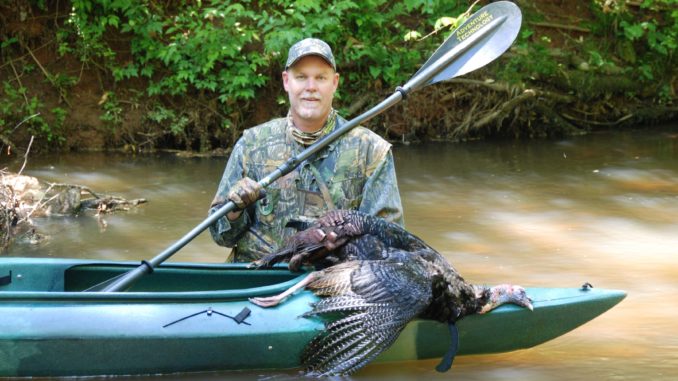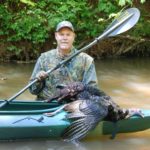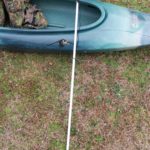
Kayaks, canoes produce all kinds of possibilities
According to the regulations posted in the S.C. Department of Natural Resources’ Rules and Regulations handbook for 2011-12, it is unlawful to take a wild turkey from a watercraft. Law enforcement officers interpret this relatively straightforward regulation to mean that you have to be out of the water before you can kill a turkey. It does not prohibit turkey hunters from accessing areas to hunt from a watercraft or that you cannot call or attempt to locate a turkey while in a watercraft.
With that caveat in mind, kayakers who also double as turkey hunters are missing out on a serious opportunity this month to take not only the average birds which, given the right set of circumstances, will mosey up a hill into the waiting arms of a hunter, but those old, tough, wise birds that practice that annoying habit of gobbling only once a day and absolutely refuse to come when called.
Integrating a canoe or kayak into your gameplan is always an option; the law dictates whether you can actually shoot from the boat, as is the case with waterfowl, or merely use the boat to access the hunt area, i.e., deer or hog hunting.
Turkey hunting from a kayak calls for a hybridized gameplan. Instead of walking an old fire break or dirt road, periodically stopping to call or glass the area ahead for signs of gobbler activity, paddling or floating a waterway adjacent to permitted hunting land allows you to move silently and call more efficiently. But when it comes time to get down to business, the law requires you to be off and out of the water.
If you compare strategies with a ground-based hunter, the situation isn’t that different. In the pre-dawn darkness, a ground-based hunter walks a dirt road dressed head-to-toe in full camouflage looking and listening for turkeys. He may pause on the road, listening for a gobbler to reveal itself, or on occasion he may call to elicit a response. Once a bird is seen or heard, he either advances to the bird to cut the distance or sets up right away by finding the closest available cover, and then tries to work the bird in.
Here’s the kayaking version. At daylight, the hunter, dressed in full camouflage — including a pair of chest waders — launches the boat, which should itself be either drably colored or concealed with netting. Face mask and gloves are already on. A mouth call, which frees both hands for paddling, is typically the preferred option. The best spots for calling are just before a bend in the river. This affords the hunter the opportunity to back-paddle and remain hidden when that ol’ bird thunders off a scant 20 yards from the water’s edge.
Just like land-based hunting, the distance between the hunter and the bird will dictate what you do when he gobbles. Similar to walking up on a strutting turkey, turning the corner to be confronted with a whole flock of turkeys scratching away on a sandbar will give you a great idea where to hunt next time, but probably won’t be to your advantage this time.
It’s safe to say that a majority of birds feel more comfortable heading downhill to the water, where they’re rarely, if ever, encountered human danger, than heading uphill to that old logging road. Assume that when he goes off, he’s coming in a hurry. Then, it’s time to hit the beach. The terrain may actually be a beach or may be a steep bank that you’ll have to scale quickly and lie flat on your stomach with gun raised to get the shot.
Such was the case on the next-to-last day of the 2011 season when I spooked three birds on a float through the Enoree Ranger District of the Sumter National Forest. For some reason, the fourth turkey to respond to a call didn’t run directly to the water but ran parallel to it for about 60 yards, then it hung up behind a fallen tree just long enough for me to get up the bank and flat in the weeds. Only the gobbler’s head was visible as he stumbled through the downed tree limbs and emerged 20 yards from the end of the gun barrel, where he was promptly greeted by two full ounces of No. 5 turkey shot.
You think the victory walk back to the truck with a gobbler slung over your shoulder is great. Try filling that tank well up with a mature bird then Palmetto Paddling down to the next take-out.
A Planned Stake Out
One piece of kayaking or canoeing gear that’s worth its weight in gold to the water-borne turkey hunter is a stake-out pole. Stake-out poles are the equivalent of a Power Pole to a bass fisherman, only the pole is driven into the bottom by hand and tethered to the boat via a short cord. Using the stake-out pole allows you to leave the boat and anchor it without having to take the time to beach the craft or lose it to the current.
Homemade stake-out poles are relatively easy to make; several manufactured versions are available. Some good manufacturers’ websites to search include captdick.net, kokomokayak.com, or austinkayak.com.






Be the first to comment